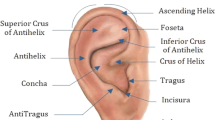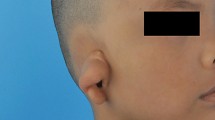Abstract
Experience with dissection of the temporal bone is essential for training in skull-base surgery, but only a limited number of neurosurgical residents have the opportunity of cadaver dissection. A modification of a commercially available prototype three-dimensional (3D) temporal bone model is proposed to include artificial dura mater, venous sinuses, and cranial nerves for such surgical training. The base 3D temporal bone model incorporates the surface details and the inner ear structures and air cells. Model dural sinuses and dura mater made from silicone, cranial nerves made from rubber fibers, and internal carotid artery made from rubber tubes were added to the model. Posterior petrosectomy (transpetrosal approach) and transcondylar approach were performed on this model using a high-speed drill and ultrasonic bone curette under an operating microscope. The modified 3D temporal bone model provided good experience with the complicated 3D anatomy. The model could be dissected, and the dural sinuses and dura mater preserved by the eggshell peeling technique in almost the same way as real temporal bone. The modified 3D temporal bone model provides a good educational tool for training in skull-base surgery.






Similar content being viewed by others
References
Begall K, Vorwerk U (1998) Artificial petrous bone produced by stereolithography for microsurgical dissecting exercises. ORL J Otorhinolaryngol Relat Spec 60:241–245
Bertalanffy H, Seeger W (1991) The dorsolateral, suboccipital, transcondylar approach to the lower clivus and anterior portion of the craniocervical junction. Neurosurgery 29:815–821
Hakuba A, Nishimura S, Inoue Y (1985) Transpetrosal–transtentorial approach and its application in the therapy of retrochiasmatic craniopharyngiomas. Surg Neurol 24:405–415
McAlea K, Forderhase P, Hejmadi U, Nelson C (1997) Materials and applications for the SLS selective laser sintering process. In: Chartoff R (ed) Proceedings of the 7th international conference on rapid prototyping. Dayton, University of Dayton, pp 23–33
Miller CG, van Loveren HR, Keller JT, Pensak M, el-Kalliny M, Tew JM Jr (1993) Transpetrosal approach: surgical anatomy and technique. Neurosurgery 33:461–469
Suzuki M, Ogawa Y, Kawano A, Hagiwara A, Yamaguchi H, Ono H (2004) Rapid prototyping of temporal bone for surgical training and medical education. Acta Otolaryngol 124:400–402
Suzuki M, Ogawa Y, Hagiwara A, Yamaguchi H, Ono H (2004) Rapidly prototyped temporal bone model for otological education. ORL J Otorhinolaryngol Relat Spec 66:62–64
Wen HT, Rhoton AL Jr, Katsuta T, de Oliveira E (1997) Microsurgical anatomy of the transcondylar, supracondylar, and paracondylar extensions of the far-lateral approach. J Neurosurg 87:555–585
Author information
Authors and Affiliations
Corresponding author
Additional information
Comments
Takeshi Mikami, Tomakomai, Japan
The training system for skull-base surgery is an indispensable tool allowing neurosurgeons to demonstrate an appropriate surgical strategy for a particular lesion. The temporal bone model can also be used as a teaching model for cranial anatomy. Unfortunately, it is not likely that this report constitutes a new approach to teaching cranial surgical techniques. However, the authors mentioned that the model could be dissected in almost the same way as real bone using a recently developed high-speed drill. The model bone might become increasingly realistic through recent advances in the model construction. The technological costs of the model bone construction should be reduced in the future so the surgical techniques can be attained more easily.
Continued use of the temporal bone model will be expected in the course of future development.
Takeshi Kawase, Tokyo, Japan
The artificial 3-D temporal bone (Kezlex), precisely manufactured resembling to the dried skull is beneficial to neurosurgeons who are not able to study it by cadaver dissection. The soft tissues such as cranial nerves, vessels and meninx are important to understand the anatomy; however, they have never been manufactured. The authors of this paper described the technique of manufacturing the soft tissues. If this model could be manufactured in a commercial base and sold with a reasonable price, it would be helpful for neurosurgeon’s education. However, the anatomical accuracy may be most important for the model and the manufacturer is requested to employ neurosurgeons as consultants, who are experts on microsurgical anatomy like the authors.
Imad N. Kanaan, Riyadh, Saudi Arabia
The best venues to teach clinical skills, sound judgment, and surgical dexterity as well as to conduct valued clinical research are the ward and operating theatre (laboratories of highest order) as correctly stated by William Halstead years ago. However, taking in consideration of patient’s safety, surgical outcome on one hand and the complexity of the intervention in the field of neurological, otological, and skull-base surgeries on the other hand, it is a prerequisite for training young surgeons to have a rehearsal or enhancement of their hand skills (Chirurg = hand, ergon = work) in an alternative set-up prior to live surgical experience. Options available are: use of navigation system, surgical simulator, attending cadaver workshops, microsurgical animal courses or using artificial models similar to the one described by the authors. In fact, a training course using well-prepared and treated cadaver samples by the masters in the field, if available and affordable, remains the best alternative option for real-time surgery considering the tactile tissue feed back the surgeon will adapt to or gain. The lack of available or adequate cadaver samples, soaring material costs and course fees have prompted the industry, with the help of modern technology, to seek a good alternative training models such as the one described by the authors; this will benefit the training of many young surgeons around the globe and, hopefully, with a drastic cut in costs.
Rights and permissions
About this article
Cite this article
Mori, K., Yamamoto, T., Oyama, K. et al. Modification of three-dimensional prototype temporal bone model for training in skull-base surgery. Neurosurg Rev 32, 233–239 (2009). https://doi.org/10.1007/s10143-008-0177-x
Received:
Revised:
Accepted:
Published:
Issue Date:
DOI: https://doi.org/10.1007/s10143-008-0177-x




